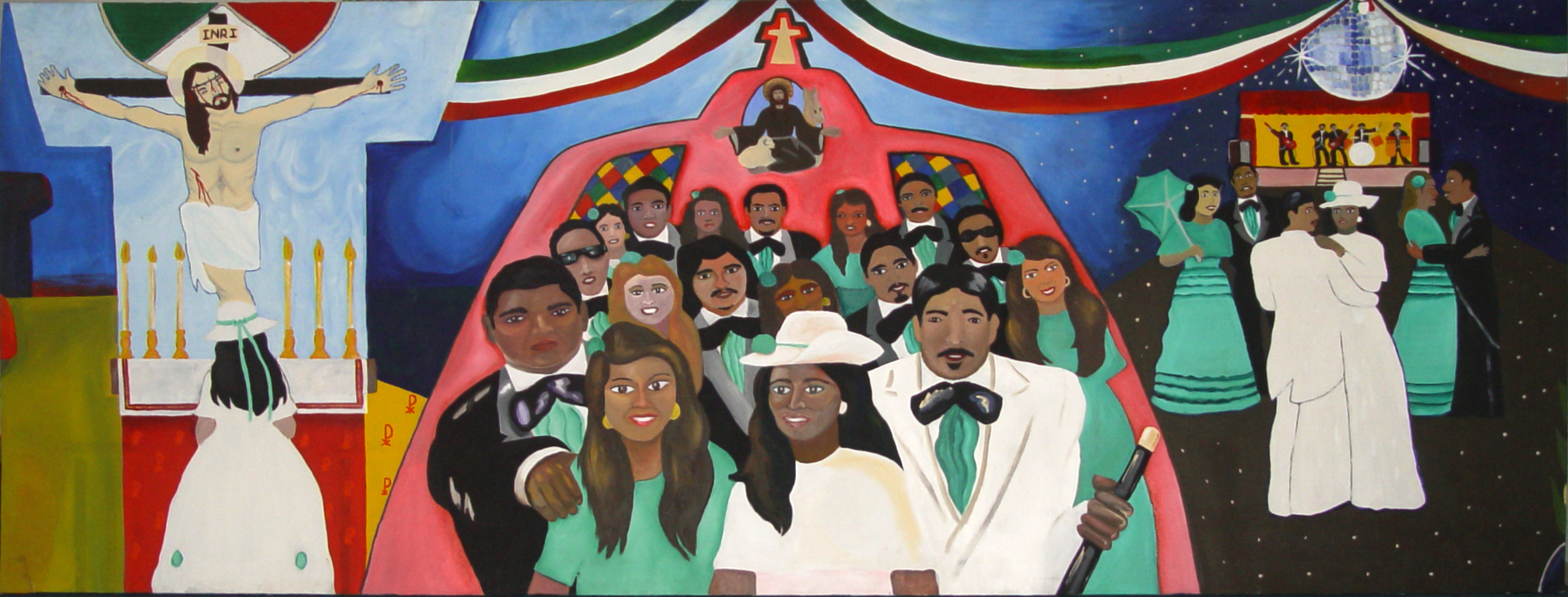
Last summer I went on a bit of fact-finding mission to little National City, just across the municipal border from San Diego’s south side. Every summer and school break when I was growing up, my mother took my siblings and me to spend time at the National City Public Library. It was a place we all liked. We went to preschool in the building next door, got library cards as soon as we were old enough, and spent long days in the stacks, absorbing stories of distant lands.
I remember a huge mural loomed from behind the library’s reception desk, depicting scenes of Mexican American life in the San Diego area in the late 1970s and early 1980s: a quinceñera celebration, students lifting up their diplomas, a backyard carne asada, a news reporter interviewing a vintage car enthusiast before the painted pillars of Chicano Park. The colors were rich, the images drawn with an appealing cleanliness, the lines easy to follow. I knew nothing about who painted the mural or how long it had been there, but I probably gazed at it hundreds of times over the years. As a child I didn’t fully understand what the images in each panel meant or represented, but I remember regarding the mural’s presence as a sort of silent anchor.
When I finally arrived to check it out, the library was shut down, the 1970s-style brown-on-brown building locked and unused. It turned out National City had built a new library a few years back, down the way in Kimball Park. When I walked over to see if the mural was there, I couldn’t find it. I asked around, spurred both by reportorial instinct and by a more personal desire I couldn’t quite identify. No one knew what I was talking about. But I needed an answer.
Upstairs, in the municipal history archive, a librarian helped me find clippings on the mural’s inauguration, on June 6, 1981. I was less than a year old at the time. “A mural depicting four facets of Chicano life – family, education, friendship and pride, will be unveiled today in ceremonies at the National City Library,” reported the San Diego Union. “Fifteen to 20 students, mostly teenagers, chose the themes. They said they did so because those aspects of Chicano life are often overlooked by the mass media. They painted the mural as part of a campaign by the library to attract more Chicano youths.” It was thrilling to read. I learned the mural’s dimensions-four panels totaling a length of 42 feet. I found that it was created as a project with a civil rights organization called PUEDO, or Proudly United for Educational Development Organizing. And the artists were local kids like me and my siblings.
I asked the librarian if he knew where the old mural might be, but it was a mystery to him as well. The National City officials I asked admitted they lost track of the artwork in the course of moving the public library from one building to another. I dug around for contacts for two artists who coordinated the mural project, David Avalos and Juan Parrino. They explained that the mural emerged in the political current of the time, making it in my view a historical document, a monument to a moment. Parrino told me that the students who painted it chose to dedicate the mural to Luis “Tato” Rivera, a young man shot in the back and killed by a National City police officer in 1975. The San Diego Union didn’t report the detail of the politically charged dedication, but Lowrider magazine did.
I kept digging. I needed to know the mural was okay. Avalos and I met up one day outside the old library and walked over to City Hall together to knock on some doors. We finally met with an administrator in the Community Services Department who promised the city was diligently searching its records and storage facilities to locate the mural.
Sometime later, they found it, in a basement storage room in City Hall. Avalos examined it and noted only a few small tears of damage. Last I checked, National City was looking to put the mural on view again.
The news soothed me. As I realized talking to Avalos and Parrino, and looking at the clips in the municipal archive, the mural is an artifact in my personal history. Its images helped shape my sense of self – as a reader, as a member of my community growing up in South San Diego, as a writer, as a journalist. Now I knew the mural must have had the same effect on other kids, and at least on the young people who helped design it.
Investigating the mural got me thinking about what “home” means to the wandering adult. I’ve lived up and down California. I’ve traveled. I live in Mexico now. My family heritage is in Tijuana. San Diego is my hometown, but it is no longer my home.
Home seems to me less a city or a place than your footprints, your archeology. I needed to find what happened to the mural behind the reception desk at the National City Public Library because I needed to relocate an essential intellectual and creative point of reference. I needed to relocate a fragment of home.
Daniel Hernandez is a journalist and writer based in Mexico City, where he contributes to the Los Angeles Times’ Latin American news blog, La Plaza. He is author of a forthcoming book, Down and Delirious in Mexico City, to be published by Scribner.
*Photo of National City Public Library mural by David Avalos.




Send A Letter To the Editors